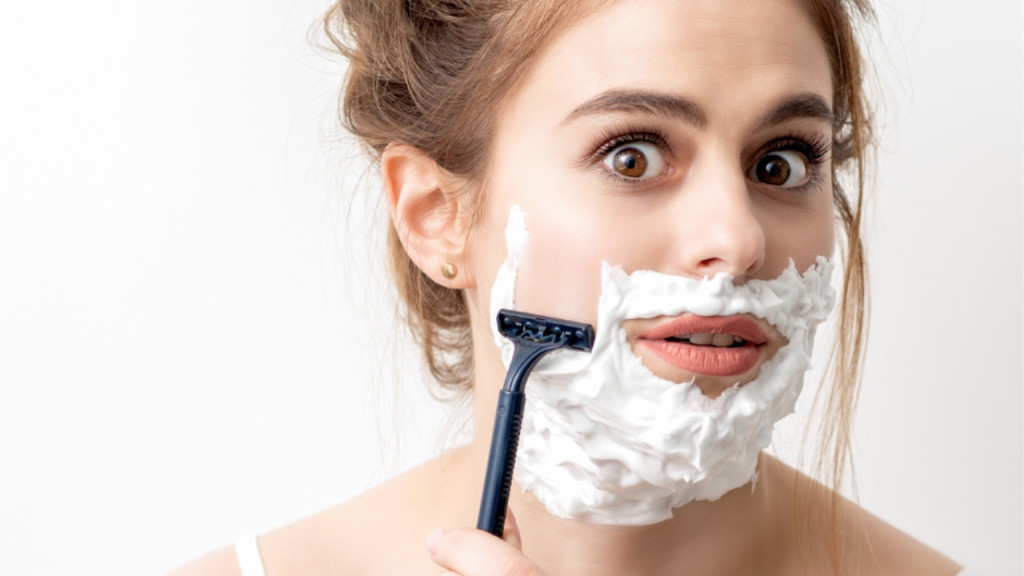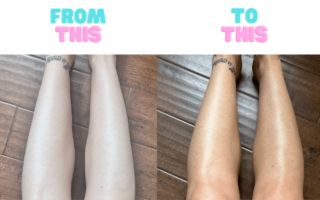
As a skincare blogger, I often come across myths and misconceptions about different skincare procedures. One of those is dermaplaning. And it’s time to debunk some common myths about it.
But first, let’s go over some basics about dermaplaning. What it is, which tools to use, and how to do it.
What is dermaplaning?
Dermaplaning is a skincare procedure that’s gaining popularity due to its numerous benefits. But also because every beauty YouTuber is doing it.
This procedure involves removing the outermost layer of dead skin cells and peach fuzz from your face using a surgical scalpel, a blade, or one of those eyebrow trimmers/razors. That means you’re not only shaving off your facial hair, but you’re exfoliating it as well.
I started doing it about 6 years ago, and I am so happy that I did because it has changed my skincare game drastically.
It’s so funny when I think about this now, but I remember a friend who told me she was “shaving her face “about 15 years ago. And I thought she was crazy. In all fairness, she really was shaving it with a razor and a foam. But still, she was way ahead of me when it came to so many things. And, if she’s reading this, I bet she’s thinking, “I told ya so “!!!
Anyhow, let’s dive a bit deeper into this trendy but worthy skincare procedure.
Is Dermaplaning Good for Your Skin?
Of course, it is! Otherwise, I wouldn’t be raving about it to all of my friends.
Dermaplaning is an effective procedure for improving the overall appearance of your skin. The result is skin that’s smoother, brighter, and with a more youthful appearance. And who doesn’t want that?!?
By removing dead skin cells and peach fuzz, dermaplaning allows your skincare products to penetrate your skin better, leading to better results. The procedure is safe for all skin types, including those with sensitive skin.
But, it’s important to note that this procedure is not recommended for people with active acne or other inflammatory skin conditions. So be aware! You can easily cut the bumps from acne or inflamed areas and worsen your condition by getting an infection.
How Often should you do it?
Dermaplaning is a gentle and non-invasive procedure that’s safe to get done every couple of weeks. Usually, four to six, even though some women do it every two weeks. I personally do it maybe once a month or when I hit the six-week mark.
This timeframe allows your skin enough time to regenerate new cells and recover from the previous procedure. However, the frequency of the treatment also depends on your skin type and condition. If you have sensitive or acne-prone skin, you may need to wait longer between treatments.
If you’re unsure how often you should do it, it’s best to consult a skincare professional. They can recommend the best frequency based on your skin type and condition.
And that would also be my recommendation to everyone in general. Go have it done the first time by a skincare professional. If it’s in your budget, of course. Otherwise, you can find numerous videos with step-by-step instructions on Youtube. Just make sure that demonstrated it’s by a reputable skincare professional.
Which dermaplaning Tools to use?
Professional dermaplaning requires the use of a sterile, surgical-grade scalpel or blade. The blade is a small, handheld tool that looks like a razor, and it is specially designed to remove dead skin cells and vellus hair without causing any damage to the skin’s surface.
The blade needs to be held at a 45-degree angle, like so:

It’s important to note that only licensed skincare professionals should perform dermaplaning with surgical-grade scalpels. Attempting to perform the procedure at home with these tools can be dangerous and can cause injury or infection.
However, there are numerous safe-to-use-at-home trimmers and razors. They are usually marketed as eyebrow razors. And, more recently, there are even little gadgets for at-home dermaplaning, like ever so popular Dermaflash. You can buy them online and in places like Sephora or Ulta.
Step-by-step dermaplaning at-home process
Here is a guide on how I do it at home using this eyebrow razor I got from Amazon.
I always do dermaplaning in the evening after washing my face and before going to bed since there are some things you shouldn’t be doing for a while after you perform the procedure. More on aftercare later on in this article.


Step 1: Clean your tool
I usually put some alcohol on a cotton pad and wipe the razor to sanitize it.
Step 2: Wash your face
Use any cleanser you would normally use, but do not exfoliate your face or use any scrubs. Dermaplaning is a form of exfoliation, so there is no need for that prior to the procedure. Pat your face completely dry with a towel.
Step 3: Dermaplaning
Hold the razor in your dominant hair under a 45-degree angle.
Start at the center of your face, close to your ear, and move towards the mouth/nose.
Pull your skin with your other hand upward (to make it tight) and start with small feathering strokes with light pressure pulling downwards, like in the gif below.
Proceed with the rest of the face going above your lips and on your chin, then move to the other side of the face starting again at the center near your ear; then do your forehead and finish with the nose.
Be very careful around your nose as it’s easy to cut yourself, and also around your eyes and eyelashes.
Bonus Tip 💡 : You shouldn’t shave upwards against the hair growth but always downwards.
Step 4: Wrapping up
Wash your face with just water to clean all the peach fuzz, dirt, and dead skin cells. Tap dry with a towel, liberally spray some nourishing face mist (without alcohol, as it would burn like hell), and top it off with a moisturizer to seal it all in.
Some people who have been using other chemical exfoliants and retinoids would apply that to the skin right after. Still, most people would find this too irritating, and their skin would burn, so I don’t recommend it.
And that’s it! Easy-peasy! Go and enjoy your super soft and smooth skin!
Dermaplaning Aftercare
After dermaplaning, your skin may feel slightly sensitive, and you may experience mild redness. This is normal and should go away within a few hours. To promote fast healing and protect your skin, it’s essential to follow a few simple aftercare steps:
- Avoid direct sunlight: Your skin may be more sensitive to sunlight after the procedure, so it’s important to avoid direct sunlight and apply SPF liberally!
- Use gentle skincare products: Your skin may be more sensitive to harsh chemicals or abrasive scrubs after dermaplaning. It’s best to use gentle skincare products that won’t irritate your skin.
- Avoid sweating: It’s best to avoid sweating or strenuous exercise for at least 24 hours after the procedure, as sweat can irritate the skin.
- Don’t pick at your skin: Resist the urge to pick at any flaking or peeling skin, as this can cause scarring or infection.
- Keep your skin moisturized: After dermaplaning, your skin may be slightly dry, so it’s important to keep it moisturized with a non-comedogenic moisturizer.
Ok, you’re bought into the story. You like everything you’ve read so far, all the benefits, how to do it, and how to take care of your skin afterward.
But I know you must be wondering if your hair will grow back darker and thicker, and now, all of a sudden, you’ll be looking more like a lumberjack. But that simply isn’t true. So let’s go over some of the most common misconceptions about dermaplaning.
Dermaplaning myths
Myth #1: Dermaplaning Causes Hair to Grow Back Thicker and Darker
This is one of the most common myths about dermaplaning. However, this is not true. Dermaplaning only removes the peach fuzz from the surface of the skin.
Peach fuzz (vellus hair) is thin and fine, and removing it does not affect the texture or color of the hair. Hair growth is determined by genetics and hormones, not by dermaplaning.
The reason why it may feel like the hair is growing darker and thicker is simply because of the contrast between the regrown hair and a smooth, exfoliated complexion. Thus, hairs appear darker when they return.
Additionally, especially if your hair is darker, you will soon adjust to the smooth, hairless look and forget what your face looks like with peach fuzz. That’s why some people believe it thickens up again because of this — but it’s simply not true.
Myth #2: Dermaplaning Causes Micro-Cuts and Scarring
Another myth about dermaplaning is that it causes micro-cuts and scarring on the skin. However, when performed by a licensed skincare professional, dermaplaning is a safe and gentle procedure that does not cause any damage to the skin’s surface. Skincare professionals are trained to use the scalpel or blade at the correct angle and pressure without causing any harm to the skin.
And if you do it at home, like I do, you’ll be using razors that are less sharp. Alternatively, you can buy the ones that have little cage protection over them. Those eyebrow trimmers and razors are pretty safe to use.
Myth #3: Dermaplaning is Only for Women
Dermaplaning is a skincare procedure that’s suitable for both men and women. Peach fuzz is a common issue for both genders, and removing it can help improve the appearance of the skin.
Men can also benefit from dermaplaning, as it can help reduce the appearance of ingrown hairs and make shaving easier.
Myth #4: Dermaplaning is Painful
Some people believe this is a painful procedure, but this is also not true. Dermaplaning is a gentle and non-invasive procedure that’s painless when performed correctly. You may feel a slight scraping sensation as the scalpel or blade passes over your skin (since it’s performed on dry skin), but it’s not painful at all.
Myth #5: Dermaplaning Causes Breakouts
There’s a misconception that dermaplaning can cause breakouts and acne. And just like other myths on this list — it’s not true. Dermaplaning removes dead skin cells and peach fuzz, which can clog pores and lead to breakouts. By removing these impurities, dermaplaning can actually help prevent breakouts and acne, not cause them.
Conclusion
Dermaplaning is an excellent way to rejuvenate your skin and give it a healthy, glowing appearance. It offers numerous benefits. And it’s very important to debunk common myths and misconceptions about the procedure to help you make informed decisions about your skincare.
This gentle and non-invasive procedure will improve your skin care regimen as you will get the most out of your products because they can be absorbed easier and deeper into your skin.
Oh, and the best part is that it will have your makeup melt into your skin and look more flawless and smooth since you won’t have that peach fuzz that makes makeup, especially powders, look cakey. 😉
I hope you got all the information needed so you, too, can start dermaplaning your face and enjoy all the benefits it offers. Please leave your comments and questions if I haven’t covered everything you wanted to know.



